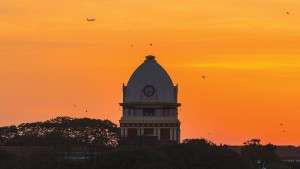Registered with the Registrar of Newspapers for India under R.N.I 53640/91
Vol. XXVI No. 02, May 1-15, 2016
The oldest college in the South celebrates its 175 years
 Presidency College celebrates 175 years, its dome and Fyson clock mark 75 years. VIJAY SRIRAM captures this picture of a striking landmark that is part of South India’s heritage
Presidency College celebrates 175 years, its dome and Fyson clock mark 75 years. VIJAY SRIRAM captures this picture of a striking landmark that is part of South India’s heritage
Marking its 175th year in a muted fashion this year is Presidency College, the oldest college in South India and the seed from which Madras University grew. But its early history has always left me with a question or two and I wonder whether some academic will shed some brighter light on those rather murky beginnings.
It was in March 1835 that the Government of India stated that “the object of Government ought to be the promotion of European literature and sciences among the natives of India.” It was an affirmation of Macaulay’s Minute on Education. But none of the Presidency governments knew quite what to do with this statement of policy. Of suggestions there was no shortage, but while Calcutta and Bombay did get around to action on some of these suggestions, Madras kept a debate going till there arrived a new Governor, Lord John Elphinstone, in 1838. To him, George Norton, then the Advocate-General, and a few other eminent personalities presented a petition in November 1939 signed by 70,000 ‘native inhabitants’ seeking institutions of higher education.
Their petition read in part, “We see in the intellectual advancement of the people the true foundation of the nation’s prosperity… We descend from the oldest native subjects of the British Power in India, but we are the last who have been considered in the political endowments devoted to this liberal object… Where amongst us are the collegiate institutions which, founded for these generous objects, adorn the two sister presidencies?” The petition also promised that the citizenry would also gladly, “according to our means”, play a role in establishing such institutions if Government gave the lead.
A month later, Elphinstone responded positively with a proposal which is still what confuses me, even if it finally resulted in the birth of Presidency College. He proposed establishing a “collegiate institution, or a ‘University’ “ with two departments: A high school offering English Literature, a Regional language, Philosophy, and Science, preparing students for the second department, the College, which would provide instruction in the higher branches of these subjects. A University Board, headed by Norton, was appointed in January 1840 to implement this proposal.
The Board gets down to work and, believe it or not, started a preparatory school! This school, started in Edin-burgh House, Egmore, and later moved to Popham’s Broadway, was meant to prepare students for the High School.
The High School opened its doors on April 14, 1841, in D’Monte House, Egmore, where the Chief Magistrate’s Court now is. Elphinstone, inaugurating the School, told the gathering, which included the School’s first 67 students, that they were “witnessing the dawn of a new era, rather than the opening of a new school.” After studying English Prose and Grammar, Arithmetic and Algebra, Moral Science, History, Mechanics, Natural Philosophy, a vernacular and, in due course, Political Economy, the students graduated as ‘Proficients’.
Eyre Burton Powell, a Cambridge Wrangler, was appointed Headmaster and in 1853 saw the High School elevated to collegiate status. Two years later, in 1855, he became the first principal of the school that had attained collegiate status and which was named Presidency College. The College moved to its new buildings on the Marina in 1870-71 by when its students were getting University of Madras degrees.
The Presidency College buildings not only pioneered Indo-Saracenic architecture in the Madras Presidency but also in India. It was the first formal affirmation of the official thinking that the Government’s public face should be in an architectural idiom that the citizenry could respond to. Thus, it is a landmark building.
It was in 1864 that the Madras Government advertised internationally a competition for the design of buildings for the first college in the South, Presidency, and the University it gave rise to, indicating that it was looking for designs that would also reflect the changed official thinking on public architecture. Robert Fellowes Chisholm, a young architect trying to make his way up in Calcutta, won the competition, arrived in Madras in 1865 to supervise their building, and stayed to change the public face of Madras.
Work on the Presidency College building began in 1867 and was completed using traditional Indian building techniques throughout its construction. In 1870, it was inaugurated by the then Duke of Edinburgh.
The dome that is today Presidency’s most visible presence, particularly with the hideous pink it has been painted in, was a later addition, marking the institution’s Golden Jubilee in 1890.
-S.M.

